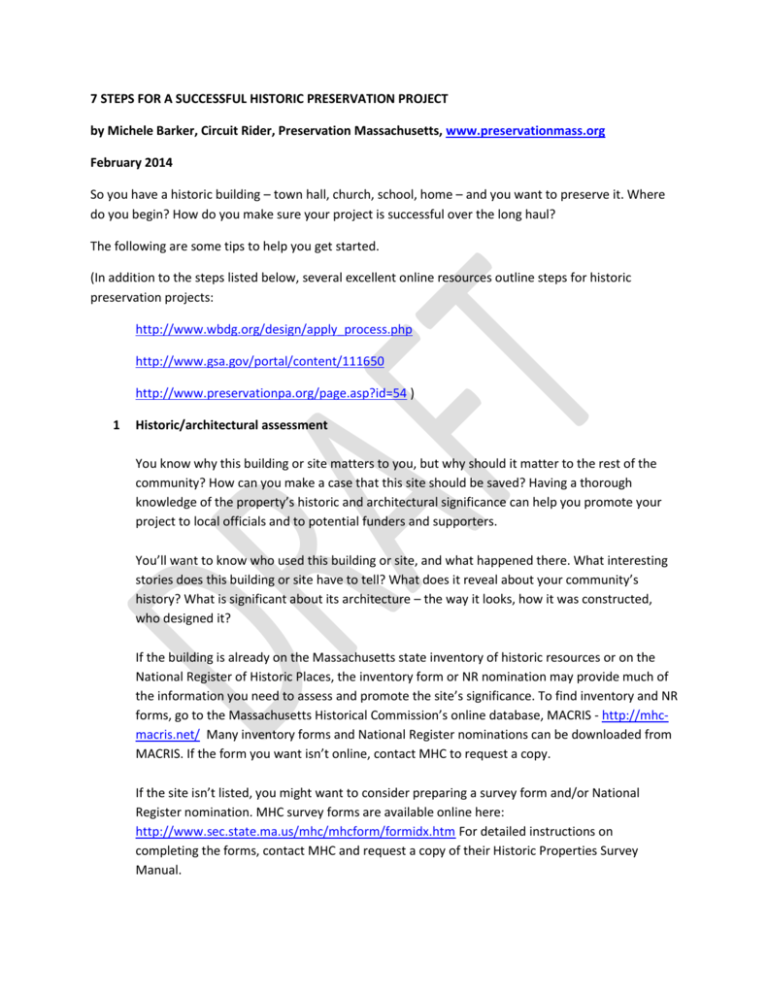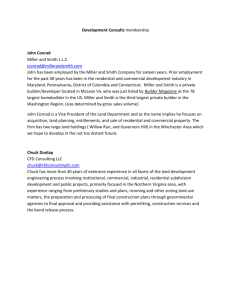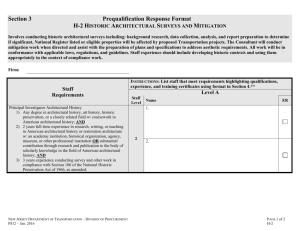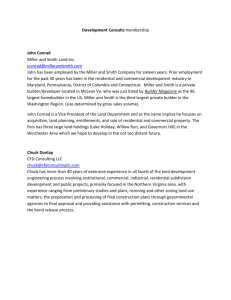7 steps to a successful project
advertisement

7 STEPS FOR A SUCCESSFUL HISTORIC PRESERVATION PROJECT by Michele Barker, Circuit Rider, Preservation Massachusetts, www.preservationmass.org February 2014 So you have a historic building – town hall, church, school, home – and you want to preserve it. Where do you begin? How do you make sure your project is successful over the long haul? The following are some tips to help you get started. (In addition to the steps listed below, several excellent online resources outline steps for historic preservation projects: http://www.wbdg.org/design/apply_process.php http://www.gsa.gov/portal/content/111650 http://www.preservationpa.org/page.asp?id=54 ) 1 Historic/architectural assessment You know why this building or site matters to you, but why should it matter to the rest of the community? How can you make a case that this site should be saved? Having a thorough knowledge of the property’s historic and architectural significance can help you promote your project to local officials and to potential funders and supporters. You’ll want to know who used this building or site, and what happened there. What interesting stories does this building or site have to tell? What does it reveal about your community’s history? What is significant about its architecture – the way it looks, how it was constructed, who designed it? If the building is already on the Massachusetts state inventory of historic resources or on the National Register of Historic Places, the inventory form or NR nomination may provide much of the information you need to assess and promote the site’s significance. To find inventory and NR forms, go to the Massachusetts Historical Commission’s online database, MACRIS - http://mhcmacris.net/ Many inventory forms and National Register nominations can be downloaded from MACRIS. If the form you want isn’t online, contact MHC to request a copy. If the site isn’t listed, you might want to consider preparing a survey form and/or National Register nomination. MHC survey forms are available online here: http://www.sec.state.ma.us/mhc/mhcform/formidx.htm For detailed instructions on completing the forms, contact MHC and request a copy of their Historic Properties Survey Manual. Preparing a National Register nomination is a good way to gather information about the building and site into one accessible resource to which you and other members of the community can refer. Being on the NR will also help your project qualify for certain grants and historic tax credits. Information about how to prepare a National Register nomination is online at http://www.nps.gov/history/nr/ Organizations in Boston, Andover, and Springfield have created excellent step-by-step guides to researching historic buildings. Although the information is community-specific, you can easily apply the instructions to similar resources in your own community. Boston http://www.cityofboston.gov/Images_Documents/How%20to%20Research%20a%20Historic%2 0Building%20in%20Boston_tcm3-18172.pdf Andover - http://www.mhl.org/historicpreservation/research.htm Springfield http://springfieldpreservationtrust.org/images/stories/pdf/springfields_buildings.pdf If you need information about architectural styles and American architectural history, you’ll find an excellent bibliography online here: http://www.uvm.edu/~vhnet/hpres/bib1.html Historic New England has an online guide to American architectural styles here: http://www.historicnewengland.org/preservation/your-older-or-historic-home/architecturalstyle-guide#first-period-post-medieval The following website has a very good illustrated architectural dictionary and guide to architectural styles - http://www.buffaloah.com/index.html Although the site focuses on Buffalo, NY, much of the information applies to Massachusetts examples as well. Once you know as much as possible about the property’s historical and architectural significance, share that information as widely as possible. Do as much as you can to make the community feel as though the building or site is something that should be cherished. If your community has a local newspaper, you might consider publishing some articles highlighting the building’s history in order to generate excitement about the project. 2 Physical assessment What is the building’s present condition? Is it structurally sound, or does it need new sills or a roof? Is water getting into the building? What needs to be done to stabilize the building and bring it up to code? You may need a variety of experts to help assess the building’s condition – architects, engineers, contractors, etc. A good preservation consultant can guide you through the assessment and rehabilitation process, assist you with locating funding sources, and help supervise contractors and subcontractors. There are a number of online directories that list preservation professionals. [link to PM list of online directories] The Louisiana Division of Historic Preservation has good information online about hiring preservation professionals http://www.crt.state.la.us/hp/nationalregister/whyhireHPprofessionals.aspx Make sure to ask your contractor or consultant what experience he or she has in dealing with buildings of the same age, materials, and construction techniques as your building. Ask for a list of similar projects and past clients whom you can contact for references. Ask if the consultant has experience working on historic tax credit or grant-funded projects. Ask if the contractor is familiar with the Secretary of the Interior’s Standards for Rehabilitation of Historic Structures. Unless the project is a small one, you’ll probably want your preservation consultant to prepare a written report of the building’s condition. There are two kinds of reports that you might be interested in having: 1) A conditions assessment provides a summary of the building’s physical problems, and includes recommendations for repair and cost estimates. 2) A historic structure report goes into more depth than a conditions assessment, particularly with regard to the building’s history and methods of construction. Not only will it discuss needed repairs, but it will analyze the sequence of construction of the building, its history and design, and its designers and builders. You can find information on conditions assessments and historic structures reports at the following websites: http://lchip.org/pdf/Historic%20Building%20Assessment%20with%20Preservation%20Guideline s%20and%20Historic%20Structure%20Reports.pdf http://www.nps.gov/tps/how-to-preserve/briefs/43-historic-structure-reports.htm http://www.architectureweek.com/2011/0518/building_1-1.html http://ohp.parks.ca.gov/pages/1072/files/historic%20structure%20report%20format.pdf http://www.nj.gov/dep/hpo/4sustain/preparehsr.pdf Once you have a thorough physical assessment of the building, you will have a good idea of what needs to be done to stabilize it and bring it up to modern safety and accessibility codes. The National Park Service has a number of technical publications and online tutorials that can help you assess your building and learn about appropriate preservation treatments. Go to: http://www.nps.gov/tps/how-to-preserve.htm 3 Finding a use for the property If the property is currently vacant, you will need to find a viable use for it. Ideally the property’s use should support the costs of ongoing maintenance. (Even if the property is occupied, you might want to assess whether it is being used as effectively as it could be.) Keep in mind that the more actively used a property is, the more likely it will be preserved over the long run. A house museum that is open only once a month is more likely to fail than a building that has multiple uses and is frequently open to the public. You might need to do an assessment of your community to learn whether there are unmet needs that your site could fulfill. Who are the potential users and/or audience for this site? Do not limit yourself to one type of user, or to the interior of the building. Can the grounds and outbuildings be used as well? Think beyond museums, exhibits, and historic programming. Could the building host dinners, parties, special events, club meetings? Could it be rented for office or classroom space, housing, artisan/craftsperson studios, retail space? Are there other organizations in the community that might want to share the space with you and become your partners in this project? Is there open land that could be rented to a farmer? Pay particular attention to uses that will bring income to the property, as it is important that the project become financially self-sufficient. A steady income stream is the best insurance that a building will be preserved over the long run. You might want to conduct surveys or have someone do a feasibility study to come up with potential uses for the building. A college or university that has a historic preservation or urban planning program might be able to provide assistance with such feasibility work, or help you set up a charette to assess potential uses. 4 Creating a plan of action Once you’ve decided what the building’s physical needs are and how the building will be used, you’ll want to come up with a plan of action. Your plan will be an important document to present to potential funders; it will show them that your concept for the building is organized and well-thought out, and that your goals are achievable. Also, if any of your project’s organizers leave the group, a written plan of action will let new members of your organization know what your goals are and keep them on track to complete the project. In addition to the rehabilitation needs outlined in the conditions assessment or historic structures report, your plan should identify the potential audience for the site, activities that will take place on the site, and the benefits the rehabilitated site will bring to the community. It should also identify long-term income sources. A good business plan can help you ensure the property will be self-sufficient over the long term. You might not be able to complete all rehabilitation work at once, particularly if the building is a large one. Work might need to be phased over several years. Your plan should include a timeline for completion of various phases of the work. In order to qualify for preservation grants or tax credits, plans for rehabilitating a property should preserve the property’s architectural and historic integrity. Paying attention to these details in the planning stage will save you a lot of grief when you begin construction. The National Park Service has some online tutorials that guide property owners through appropriate rehabilitation techniques here, with many illustrations for correct and incorrect rehab work: http://www.nps.gov/tps/education/online-training.htm 5 Finding Funding How will you pay for your preservation project? Will you apply for grants, ask for donations, take out a loan, use historic preservation tax credits? There are many ways to fund your project, and you’ll probably want to take advantage of as many as possible. Preservation Massachusetts has a list of many funding resources here [link to wherever funding list goes] The Library of Congress has a directory of foundation grants for museums, archives, and libraries online here: http://www.loc.gov/preservation/about/foundtn-grants.pdf The Foundation Center’s online Foundation Directory lists thousands of grant resources: https://secure1.foundationcenter.org/fdo/signup This service is available by subscription only. However, many libraries have subscriptions to this resource or have print copies of the directory. Fundsnetservices.com has a free online directory of grants and foundations, searchable by type of grant. Your project might be eligible for more funding assistance than you think. While there are only a few grant, loan, and tax credit programs specifically targeted at historic preservation projects, many preservation projects include cultural, arts, education, and environmental components that may qualify them for other types of funding. When looking for funding assistance, consider all aspects of your project. Are you trying to make your building energy efficient, or are you working on a historic park or other landscape project? Then you might qualify for a grant from an environmental organization. Can you incorporate an educational element into your project to teach people about the historical, cultural, or architectural aspects of your site? Then you might qualify for an arts, cultural, or educational grant. Will your project enhance your community, promote tourism or business, or create housing? Then you might qualify for community development funding. Explore as many opportunities as you can. Creating a written fundraising plan can help you identify potential funding sources and decide on the best tactics for approaching them. There are many online resources that can walk you through the process of creating a fundraising plan. Some sites that might be worth checking out: The Network for Good has a number of free online publications and checklists to guide nonprofits through fundraising and grant seeking. Go to www.fundraising123.org Fundraising planning worksheet http://www.fundraising123.org/files/KleinNP911_Fund_Plan_Worksheet.pdf The Nonprofit Alliance has an online guide to creating a yearlong fundraising plan here: http://www.nonprofitalliance.org/system/res/135/original/tool_06.12.pdf The Nonprofit Alliance also has resources on grant seeking and writing and many other topics here: http://www.nonprofitalliance.org/resources?cat=1 Ten Steps to Creating Your Fund Development Plan: http://fundingchangeconsulting.com/wordpress/wpcontent/uploads/2010/02/creating_a_fr_plan_worksheet.pdf Creating a 60-day Fundraising Plan http://www.tripointfundraising.com/creating-a-60-day-fundraising-plan-days-1-15/ The National Trust for Historic Preservation has several lists of tips for fundraising: http://www.preservationnation.org/main-street/main-street-news/story-of-theweek/2012/121107fundraisetips/10-tips-for-year-end.html http://www.dhcd.virginia.gov/MainStreet/TrainingArchive/2010/4.%20Successful%20Fu ndraising%20Ideas.pdf http://www.greenfieldma.gov/Pages/GreenfieldMA_BComm/Historical/FundraisingTools08.pdf If you’re planning on applying for a grant, make sure you learn as much as possible about the grantmaker. If possible, obtain a list of projects they’ve funded in the past. You might want to contact past grant recipients to learn about their experience with the funding source. Many grantmakers will provide examples of successful grant applications, and will give guidance on how to prepare a good application. Some even provide workshops or tutorials for grantseekers. The Community Toolbox has step-by-step guidelines for writing a grant application: http://ctb.ku.edu/en/dothework/tools_tk_14.aspx Don’t limit your fundraising efforts to grants and foundations. Solicit donations from local businesses and individuals, plan special events and activities, and think about ways that your site can generate income. The more varied and creative your fundraising activities are, the better your chances of success. 6 Construction You’ve determined your building’s physical needs, and have raised enough money to get started on construction. How do you find good consultants and contractors? PM has two publications that address that issue [link to online contractor directories & to selecting contractor tipsheet]. In addition, the FTC has a brochure on contractor evaluation online here: http://www.consumer.ftc.gov/articles/0242-hiring-contractor The National Trust for Historic Preservation has tips for selecting and working with contractors here: http://www.preservationnation.org/resources/technical-assistance/floodrecovery/additional-resources/32-Working-with-Contractors-and-Architects-Finding-Suppliesand-Furnishings-for-your-Historic-Home-or-Building.pdf You might want a preservation consultant to act as a construction manager for your project. A good preservation consultant will make sure that all work meets the appropriate preservation standards; this is particularly important if you’re applying for preservation grants or tax credits. In general, a good historic preservation project should meet the Secretary of the Interior’s Standards for Rehabilitation. You can find out about the standards at the National Park Service’s website: http://www.nps.gov/tps/standards.htm The NPS site also has good tutorials on the Standards as well as technical publications about many details of construction, from roofs to foundations. 7 Maintenance Your project is complete, you’ve had a ribbon-cutting, and now you can sit back and relax, right? Well, not quite. If you want to make sure that your building stays preserved, you’ll need to plan for maintenance. Good maintenance plans and procedures will ensure that you catch small problems before they become big, expensive ones. A written maintenance plan and good record-keeping will help you keep track of when and how maintenance and repairs were done, who did the work, and how much it cost. You’ll want to create a schedule for regular inspections of the building and for chores that need to be done at regular intervals (painting, puttying windows, cleaning gutters, etc.). Know the approximate lifespan of roofs and other building components, and plan for repairs before water starts getting into the building or paint starts peeling. You’ll want to set aside funds for anticipated large repairs, like roofs, so that you’re not caught empty-handed when expensive repairs crop up. Even with the best maintenance plan, the unexpected happens – storm damage, a burst pipe that floods the basement, etc. Plan for disasters before they strike. Make sure that you have an emergency fund set aside for such occurrences. Make sure your insurance is up-to-date and that the property is insured for full replacement value. The National Trust for Historic Preservation has a long list of websites that can help you with disaster planning - http://www.preservationnation.org/resources/technical-assistance/disasterrecovery/cultural-institutions-prep.html#.UadhAJywVvo (If you’re having difficulty finding appropriate insurance because of the historic nature of your property, you might try contacting National Trust Insurance Services, which specializes in insurance for historic properties - http://nationaltrust-insurance.org/ ) The following websites provide information and models for maintenance planning. The National Park Service has a publication on maintaining historic buildings here: http://www.nps.gov/history/hps/tps/briefs/brief47.pdf Online manual for maintenance http://www.historycolorado.org/sites/default/files/files/OAHP/Programs/SHF_CMPlan_Mai ntenanceManual.pdf The Whole Building Design Guide has an online resource that discusses creating an Operations and Maintenance Plan for historic structures. http://www.wbdg.org/resources/omhs.php?r=ensure_health Maintenance Guide for Historic Homeowners http://www.carson.org/Modules/ShowDocument.aspx?documentid=32085 Historic New England’s recommended maintenance schedule for historic properties: http://www.historicnewengland.org/preservation/your-older-or-historichome/recommended-maintenance-schedule







